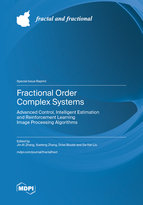Fractional Order Complex Systems: Advanced Control, Intelligent Estimation and Reinforcement Learning Image Processing Algorithms
A special issue of Fractal and Fractional (ISSN 2504-3110). This special issue belongs to the section "Engineering".
Deadline for manuscript submissions: closed (30 November 2024) | Viewed by 30985
Special Issue Editors
Interests: fractional-order systems; nonlinear systems; multi-agent systems; prescribed performance control; nonlinear control
Special Issues, Collections and Topics in MDPI journals
Interests: singular systems; fractional systems; robust control
Special Issues, Collections and Topics in MDPI journals
Interests: non-asymptotic state estimation; non-asymptotic fractional order differentiator
Special Issues, Collections and Topics in MDPI journals
Interests: estimation and control for fractional order systems; numerical solutions for fractional order differential equations
Special Issues, Collections and Topics in MDPI journals
Special Issue Information
Dear Colleagues,
Over recent years, a growing number of authors’ works from various science and engineering fields have dealt with dynamical systems, described by the connection between the theory of artificial intelligence and fractional differential equations, and many computational fractional intelligence systems and stability analysis and image processing applications have been proposed. The aim of this Special Issue is to gather articles reflecting the latest developments in applied mathematics and advanced intelligent control engineering related to the interdisciplinary topics of control, fractional calculus, image processing, and their applications in engineering science.
Fractional calculus and fractional processes, with applications in control systems and image processing, represent a hot topic. Fractional order systems are a natural generalization of classical integer order systems with the capacity to accurately describe many real-world physical systems. The fusion and noise suppression of medical images have become increasingly difficult to ignore in image processing, and these techniques provide abundant information for clinical diagnosis and treatment. Image fusion is a significant factor in image processing owing to the increase in image acquisition models. Recently, fractional operators have played an important role in image processing. Additionally, powerful fractional operating tools have been introduced, possessing extensive applications in the analysis and design of nonlinear control systems. Singular systems are governed by so-called singular differential equations, endowing the systems with many special features not found in classical systems. The approaches of fractional order control systems, which borrow from those of integer order control systems, are attracting increasing attention within the control field.
We invite the submission of high-quality articles in this field by researchers and experts in academia and industry.
Dr. Jin-Xi Zhang
Dr. Xuefeng Zhang
Prof. Dr. Driss Boutat
Dr. Da-Yan Liu
Guest Editors
Manuscript Submission Information
Manuscripts should be submitted online at www.mdpi.com by registering and logging in to this website. Once you are registered, click here to go to the submission form. Manuscripts can be submitted until the deadline. All submissions that pass pre-check are peer-reviewed. Accepted papers will be published continuously in the journal (as soon as accepted) and will be listed together on the special issue website. Research articles, review articles as well as short communications are invited. For planned papers, a title and short abstract (about 100 words) can be sent to the Editorial Office for announcement on this website.
Submitted manuscripts should not have been published previously, nor be under consideration for publication elsewhere (except conference proceedings papers). All manuscripts are thoroughly refereed through a single-blind peer-review process. A guide for authors and other relevant information for submission of manuscripts is available on the Instructions for Authors page. Fractal and Fractional is an international peer-reviewed open access monthly journal published by MDPI.
Please visit the Instructions for Authors page before submitting a manuscript. The Article Processing Charge (APC) for publication in this open access journal is 2700 CHF (Swiss Francs). Submitted papers should be well formatted and use good English. Authors may use MDPI's English editing service prior to publication or during author revisions.
Keywords
- image processing
- image fusion
- image denoising
- image enhancement
- analysis and control of fractional systems
- singular fractional systems
- intelligent fractional control
- high-performance control
- non-asymptotic fractional state estimation
- fractional numerical solution and simulation
Benefits of Publishing in a Special Issue
- Ease of navigation: Grouping papers by topic helps scholars navigate broad scope journals more efficiently.
- Greater discoverability: Special Issues support the reach and impact of scientific research. Articles in Special Issues are more discoverable and cited more frequently.
- Expansion of research network: Special Issues facilitate connections among authors, fostering scientific collaborations.
- External promotion: Articles in Special Issues are often promoted through the journal's social media, increasing their visibility.
- Reprint: MDPI Books provides the opportunity to republish successful Special Issues in book format, both online and in print.
Further information on MDPI's Special Issue policies can be found here.









